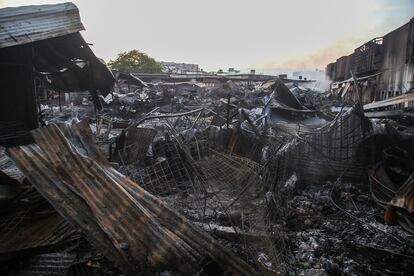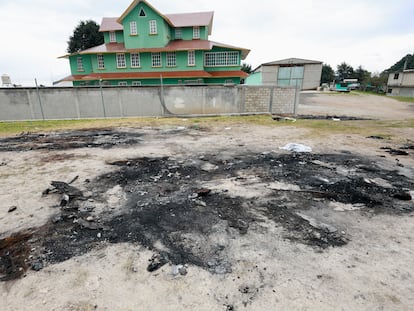Organized crime puts a price on Mexican agriculture
The countryside is losing millions of hectares of crops due to land being abandoned. Violence and extortion add to the ravages of climate change and the lack of subsidies

On December 8, the umpteenth massacre on Mexican soil left 14 dead bodies in the town of Texcaltitlán, about 80 miles from the capital. This was the result of a confrontation between farmers and hitmen. The horror recorded on video conveys the dark times that agricultural activity is going through, due to the extortion of the cartels. It’s no longer just poppy blood that waters crop fields. Corn, coconut, sorghum, avocados, lemon, mango and Jamaica flower — the entire rural world — succumbs to the taxes that the mafias impose on land use, production, harvests, and sales.
Organized crime has put a price on the soil where farmers work and live. This is an added cost to the unavoidable consequences of climate change, the lack of government subsidies, and the aging of the farming population in Mexico. Over four million hectares of crops have been abandoned in the last three years alone, according to data from the National Union of Agricultural Workers (UNTA). Young people have migrated away from the countryside.
With the poetic language of those who grow up in nature, Zenaida Correa Juárez expresses it best: “People no longer grow up with a guajiro [countryside] dream.”
Mexico’s rural area consists of 191.7 million hectares, of which 21.6 million is cultivated. Just over a quarter of this is irrigated, while the rest is seasonal. That is, at the mercy of the weather. And 2023 wasn’t generous in terms of water.
A few weeks ago, the farmers of Texcaltitlán, a town in the state of Mexico (Edomex), brought their concerns to members of the organized crime organization La Familia Michoacana. On December 8, this criminal cartel approached them to demand their illegal tax, at a rate of one peso for 10 square feet. The farmers pleaded that they couldn’t pay — the exorbitant fees were depleting their profits. But they didn’t just come with words: they were armed with machetes, pistols and sticks. Eventually, fighting broke out. And this time, the drug traffickers made up the majority of the victims, as the farmers were fed up with the centuries-old practice of extortion that has plunged them into poverty. If, in a distant time, it was the colonialist chiefs who engaged in this practice, it’s now organized crime that wants to keep the fruit of the land, without having worked for it.
It’s not easy to place blame in Mexico. “Criminals don’t come from outside. They’re born here. They’re also children [who have grown up with] lack of opportunities, poverty, hunger and ignorance,” explains Marco Antonio Reyes, the leader of the UNTA in the state of Guerrero, one of the most fertile and violent regions in the country. Loaded with biodiversity, the state ranks first in terms of the production of mango, coconut, and Jamaica flower.
Still, agricultural activity has been stifled by “60 years of backwardness in the methods of production,” with animals still being used to plow the land in a good part of the state, given the high cost of tractors. Young men are no longer satisfied with the slavery-like conditions of the countryside that are passed down from generation to generation.
“I’ve seen, in a single town, 10 buses filled with young people [who are leaving],” Reyes laments. “When the corn harvest arrives, there’s no labor.” In Guerrero, where 70% of the rural population is aged over 50, the equation is clear: poverty and violence are resulting in the abandonment of the farms. According to the UNTA, the average age of farmers is even higher in other states.
Three-quarters of a century — with all their seasons — are reflected in the face of Eudosio Martínez Fausta, a subsistence farmer from Chapa de Mota, in Edomex. For years, he’s been fighting to return to the lands that were stolen from him overnight with administrative tricks, something common in Mexico. An edict was prepared that granted others the rights to some of his property, while a clever village chief shuffled the papers around. In 2015, officials and bulldozers arrived to demolish the homes.
“From then on, I was like a feather in the air,” Eudosio sighs, not knowing where to stay or what to do with his life. Today, he and his family are settled on a small plot of land, in structures built out of cement blocks that don’t protect them from the cold or the heat. Every day, they try to protect their remaining land and crops, fearful of further dispossession.
In this breeding ground, many of the massacres in Mexico ferment and explode. In the past, some village chiefs were punished by hanging. But the farmers always bore the brunt. To combat injustice, more than 40 years ago, Álvaro López founded the agrarian organization UNTA. Today, he’s still the national leader. Over the past four decades, especially in the 1980s and 1990s, 1,362 fellow rural activists lost their lives. López is very careful on his roadtrips, wary of ambushes. Not only are abductions carried out by organized crime: sometimes, powerful agricultural businesspeople order them, colluding with local politicians.
“When my father had the land,” Eudosio recalls, “he didn’t know what to do with it, because he didn’t have a team to till [the soil].” Today, he’s inherited some of the plots, but there are no tractors. Pushing the plow behind the horse is one of the most tiring tasks in the field — it’s a fight against the earth, inch by inch. Zenaida Correa Juárez also complains about this: “We need tractors, the team is no longer performing. And the cost of fertilizer has gone up a lot.” Her two sons went on to other jobs, which is why she maintains that the countryside dream is no longer on the minds of young people.
Unharvested cornfields flank the highway on the way to Chapa de Mota. “The harvest is lost,” López grumbles. He gets out of the car and jumps over a ditch. He plucks a ruined ear of corn from the ground. All around him, you can see the destruction of the last rains. The water arrived at the wrong time — there’s no way to harvest anything for now. The farmers must wait to see if the weather dries up.
This past Wednesday, though, the sun welcomed one of the candidates for MORENA, the ruling party, to the municipality. Under a precarious tarp, about thirty farmers received him with carnitas and hot punch. Then, they took to the floor, asking him to fix the roads, bring electricity, connect the water… to not ignore them when he reaches power. Afterwards, they ate tacos, rice and green mole, with the chickens clucking outside the tent.
López, as the agrarian president, had also been invited to the political gathering. The UNTA has given its support to MORENA’s presidential candidate for the elections in June of 2024, but the union is still critical. “All countries subsidize their agriculture, but this government — in order to combat corruption — has taken drastic measures. The rural support programs, which were created long ago, have been eliminated. The absence of development policies is the main cause of land abandonment,” López emphasizes.
“Yes, there was corruption and mismanagement of resources, which either partially arrived, or didn’t arrive at all, under the policies that were typical of past regimes. Agrarian organizations and complicit officials did some business [on the side] and others turned a blind eye… but these programs are needed,” the union president says. “In this past six-year [presidential] term, the baby has been thrown out with the bathwater.”
70% of the fertilizers used to come from Ukraine and Russia. Hence, everything has now become significantly more expensive due to the war. With data from the UNTA — collected by the organization in the 30 Mexican states where it has a presence — López assures EL PAÍS that there are no more than 14 million hectares under cultivation in the country. He maintains that at least 30% of the Mexican rainfed area has been left idle.
In 1993, the union leader explains, the harvest set a record, because prices were clearly set and people worked hard because of that incentive. After that year passed, he laments, everything has gotten worse.
Five years ago, cartel bosses began to impose their quotas on farmers in some states, first based on the harvest, now per square foot. The farmers suffer from this in Guerrero, in Sinaloa, in Durango, in Guanajuato… they suffer everywhere; there’s no escape from the extortion.
“In the greenhouses [the criminals] charge one peso per [10 square feet] per month. And, if it’s corn, the farmers have to sell it to the collectors — also from the mafias — who pay you [very little]. Everything passes through their hands: the beans, the fruits. They also buy livestock from breeders and butchers, who are obliged to sell it to them. They’ve taken over all links of the supply chain,” explains Marco Antonio Reyes by phone from Guerrero. About three months ago, the gangsters burned the central market of Acapulco. And, a few months before that, they killed several chicken farmers in Chilpancingo, the state capital.

The UNTA criticizes “the welfare system” implemented by the government, which helps with some of the difficulties that are weakening the rural world, but — according to them — doesn’t encourage production. “We must invest in production and innovation and create a solid financing system that injects resources [into the countryside]. And not only for farmers who cultivate one hectare for subsistence,” Reyes clarifies. “The credits are being given out by coyotes (illegal operators) at a very high interest rate. It’s the same thing that happened in colonial times: the chiefs leased out land to cultivate and then demanded part of the harvest.”
“We need,” Reyes adds, “a productive agricultural infrastructure. That is, warehouses, silos, machinery to process mangoes and coconuts, but with a high-impact vision, not just a local one.”
López says goodbye to the farmers of Chapa de Mota. The sun is still high. He carries some free-range eggs that have been given to him as a gift. He gets into the car. Next to the dirt road and dry cornfields, a young woman and her son suck on a candy stick and wave goodbye.
“We’re approaching a stage of greater violence due to hunger,” the agrarian leader predicts. “[The only reason] the country hasn’t gone bankrupt is thanks to the remittances that come from the United States.”
The spiral continues its course. Those who leave the countryside and cross the border will send back money, with which their families will survive… albeit without excess resources to jumpstart production. There are towns all over Mexico where there are only women, children and the elderly left. The men of working age have already gone north, to work the fields that are not theirs.
Sign up for our weekly newsletter to get more English-language news coverage from EL PAÍS USA Edition
Tu suscripción se está usando en otro dispositivo
¿Quieres añadir otro usuario a tu suscripción?
Si continúas leyendo en este dispositivo, no se podrá leer en el otro.
FlechaTu suscripción se está usando en otro dispositivo y solo puedes acceder a EL PAÍS desde un dispositivo a la vez.
Si quieres compartir tu cuenta, cambia tu suscripción a la modalidad Premium, así podrás añadir otro usuario. Cada uno accederá con su propia cuenta de email, lo que os permitirá personalizar vuestra experiencia en EL PAÍS.
¿Tienes una suscripción de empresa? Accede aquí para contratar más cuentas.
En el caso de no saber quién está usando tu cuenta, te recomendamos cambiar tu contraseña aquí.
Si decides continuar compartiendo tu cuenta, este mensaje se mostrará en tu dispositivo y en el de la otra persona que está usando tu cuenta de forma indefinida, afectando a tu experiencia de lectura. Puedes consultar aquí los términos y condiciones de la suscripción digital.
More information
Archived In
Últimas noticias
Maduro pleads not guilty before the federal court in New York: ‘I am still the president of Venezuela’
A new test can detect Alzheimer’s from a finger prick
UN team enters Sudanese city of El Fasher after paramilitary massacre: ‘It’s like a ghost town’
A recipe for resistance: Indigenous peoples politicize their struggles from the kitchen
Most viewed
- Gilles Lipovetsky: ‘If you want to live better and fall in love, take Prozac, don’t look to philosophy’
- Alain Aspect, Nobel laureate in physics: ‘Einstein was so smart that he would have had to recognize quantum entanglement’
- Alvin Hellerstein, a 92-year-old judge appointed by Bill Clinton, to preside over Maduro’s trial in New York
- Why oil has been at the center of Venezuela-US conflicts for decades
- Cuba confirms death of 32 of its citizens in the US attack against Venezuela










































